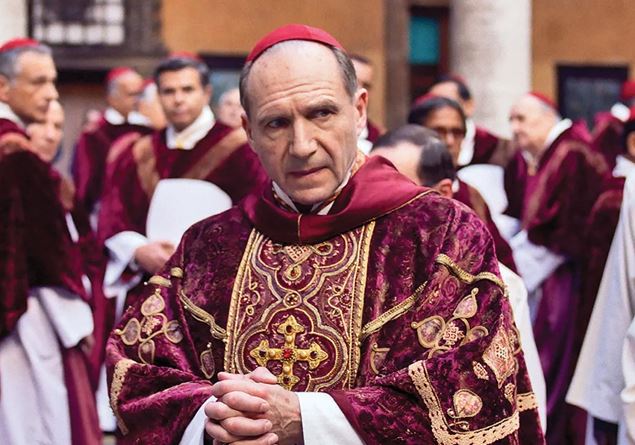
After the sudden death of the ruler, those who are responsible for electing the successor come from all over the world to gather, isolated from the world, and decide who among them will take the place of the deceased. To be conquered is the oldest kingdom in history and the largest dominion on the planet: at stake are power, prestige and a dark mission to be accomplished that an enigmatic spirit should guide. The election is according to an ancient and secret ritual but the complexity of the world knocks (or rather explodes) at the windows of this complex and oligarchic election, trying to impose its own themes and times. An election in which there is no shortage of twists and turns, after all the hearts of men (male, and not only, in this case) become stony and ferocious when fighting for power.
Forgive the extreme summary but this is the plot of Conclave, a film by Edward Berger scheduled in Italy for the Christmas holidays.
It matters little whether this process will lead to the election of the Pope of the Catholic Church or the monarch of a fantasy kingdom set in the present day.
It is not the first time that cinema (and literature, the film is based on the novel of the same name by Robert Harris) are attracted by the evocative rites and secrets of the election of a pontiff. Many have measured themselves, with different results: many to bend reality to their own spectacle (as in this case), very few to try to understand an aspect of it, even a partial one (Habemus papam by Nanni Moretti, for example).
Edward Berger, skilled in television series, knows how to make excellent cinema (the three Oscars for “All Quiet on the Western Front” bear witness to this) and in this work he enriches the language with a lot of theatre, to present with quick brushstrokes on the stage of Santa Marta and the Sistine Chapel (grandiosely reconstructed by the Cinecittà workers) the contenders for the papal throne and the various king makers.
If Oscar is for this fifth feature film, it will be for one of the members of a remarkable cast: Ralph Fiennes, Stanley Tucci, John Lithgow, Isabella Rossellini. Also noteworthy are the performances of two other Italians, Sergio Castellitto and – for a small but intense part – Roberto Citran.
The direction is solid, fast and capable of extremely animating the potential static nature of a permanently sedentary meeting of no longer young males, thanks to the camera movements, the architectural details, the quick close-ups of the voters composed with the long shots of the cloisters or of the constricting corridors.
The quotes are also evocative, such as the “wind” of the spirit which – as in the funeral of John Paul II – shakes the electors gathered in the Sistine Chapel or – when the drama of history explodes on the cardinal electors – the visualization of the work The ninth hour by Maurizio Cattelan.
The photography is superb in amplifying the narrative tension with the contrasts between the dark colors of the interiors of Santa Marta and the purple red of the cardinals; the shining light that is “outside”, with the suffocating darkness “inside” (choices that alone express the prejudice that animates the story).
The original soundtrack by Volker Bertelmann is remarkable, to the point of wanting to listen to it in its entirety and independently.
Let’s spare more details of the plot and the roles of the characters, and not only to avoid spoilers: it is enough to pour on the more or less known basis of the procedure for the election of a pope a good dose of clichés about the divided Church (between progressives and conservatives), a handful of infighting, a garnish of unspeakable secrets, all peppered with political correctness and a sprinkling of issues taken from the woke galaxy. Et voilà, the dish is ready.
A pleasant, enjoyable dish, no doubt about it, we are talking about a film made with mastery (an international production shot entirely in Italy) but as happens with certain desserts, the excess of cream and sugar ultimately tire and above all well they leave little impression on the palate, neutralizing the taste of what is authentically valuable (and there is artistic and technical substance in this film).
The desire to show that what is told in the film is the reality of things (and not a free invention, even if it were about the hypothetical election of a phantom pope) is evident in the choice of fidelity in reconstructing the environments, the clothes of the cardinals, in proposing formulas and rites of the conclave. A loyalty (sometimes awkwardly limping, like when the cardinals call each other “colleague” like tram drivers at the bar, but let’s not quibble too much) that wants to instill in the spectator the impression of being led in an exclusive way where no one can enter to make themselves known. then I take into account the dark and sinful side of the church, precisely in the place where it decides about itself.
Don’t be impressed by the authenticity of some dialogues which seem to want to deliver suggestive truths to the church and believers which – just a second viewing – actually have very little of the evangelical about them. Unfortunately it is dramatically true, as “Conclave” shows, that sins in the church and in churchmen are not lacking and are not even a rarity.
But this “showing” is not the limit of the film. Cinema is free to invent and tell the stories it wants, to stigmatize defects and errors, to denounce the mismatch between ideals and practice also with regard to the Church and the sacred: it is a principle that must always be recognized and affirmed. Just as it is necessary to recognize and affirm that when the elements of reality are used predominantly, it is not correct to use only their limits and defects to articulate the story, distorting those elements of reality in the conclusions: uchronia or dystopia – in the case of Conclave – are something else.
by Don Davide Milani, official of the Dicastery of Culture and Education of the Holy See and president of the Entertainment Organization Foundation







